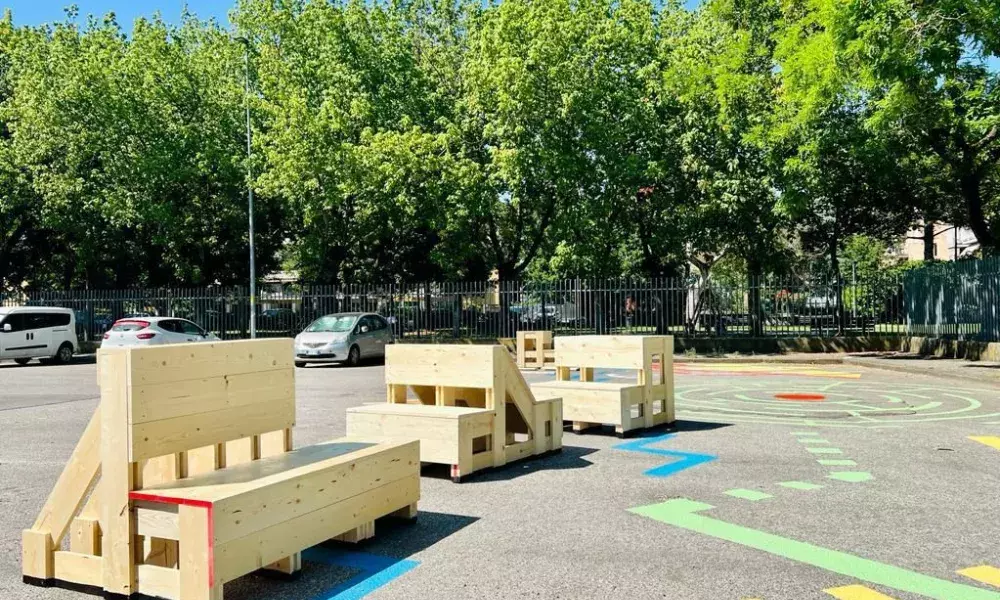Laboratories of self-construction: a benefit for the community and the common good, as well as an opportunity for new social relationships.

The S.T.E.P.S. project has been active in supporting processes that aim to promote citizens’ participation by co-creating and suggesting new ways to improve the quality of community space.
Targeted, effective, and sustainable interventions in urban areas throughout the project have been promoted by the Municipality of Verona, alongside the project partner Energie Sociali Cooperativa Sociale, with the double benefit of restoring disadvantaged urban areas and creating opportunities for social interactions, while also strengthening the sense of community.
One of the crucial steps in rethinking of public space is planning the interventions through a participatory dialogue with citizens. This approach certainly gives importance to the relationship between citizens and their city, creating a direct connection between people and the context where they live.
By bringing together groups of citizens of all ages and advocating for self-construction practices, the S.T.E.P.S. project aimed to redevelop abandoned but potentially valuable urban spaces. These practices included tactical urbanism elements, like ground paintings, murals, urban and street furniture construction.
During the initial phase of the S.T.E.P.S. project, each partner played a role in mapping the 3rd District of Verona from a social, environmental, and potential perspective. In this way, 19 areas were identified and classified according to their degree of interest for the purpose of urban regeneration.
An exploration, especially of the green areas, was carried out involving local teenagers. They collected ideas, visions, and proposals that could bring new beauty and vitality to urban environments that are part of their daily lives.
The next step saw engagement and participation reaching out to citizens from all backgrounds and ages, including young and old people, citizens, and neighborhood associations, together to make a difference and actively change the aesthetics of these spaces to make them more welcoming and return them to use by the community.
The workshop Si può fare (You can do it) focused on the restyling of the green areas in Borgo Nuovo quarter. Several proposals for improving these green areas were collected during the workshop, such as creating a book-crossing zone, new street furniture, and a new sports area for children and seniors.
Starting from these ideas, the S.T.E.P.S. project supported some urban regeneration interventions such as murals in front of schools, maintenance of furnishings, planting of flower essences and flower beds. Some of these interventions took place during social entertainment initiatives in the area, such as the Festa d’Autunno (Autumn Festival), Borgo Nuovo si Attiva (Borgo Nuovo is active), Carnevale a Borgo Nuovo (Carnival in Borgo Nuovo), and Festa dei fiori (Flower Festival).

In the Borgo Milano quarter the project’s key idea was to renew Piazza Marinai d’Italia. The workshop La Piazza che non c’è (The Square that is not there) was developed in two phases. As a first step, it was decided to renovate the pavement of the square in order to create a multifunctional platform. Through the insertion of colors and drawings on the pavement, people were invited and encouraged to use this space in a new playful way. At a second step, the project included designing and self-constructing street furniture, which could also act as filters and protection for children from nearby parking spaces. The neighborhood community took part in both phases. Students and teachers from Uberti and Fedeli schools, as well as their parents, and the neighborhood, were involved in planning and executing the project: the students, with the help of facilitators, created sketches of the drawings to be made on the ground; the teachers were instrumental in involving various social players, including parents and citizens in the workshops on pavement painting and self-construction.
The instantaneity of these interventions gave the opportunity to act quickly and test solutions with a strong visual impact. In this way, urban livability can be significantly improved within a short time.
Coloriamo il Basson! (Let’s color the Basson) was the workshop carried out in the Basson quarter, mainly with the participation of adolescents and children who reported the lack of leisure, sporting and playful facilities to gather young people in the Basson area to spend their spare time. All the project activities have been decided according to the needs and indications of the adolescents to provide Basson with an equipped area suitable for children.
The intervention site (a small square) was chosen as the best location because it was unused but has great potential, and the type of paintings depicting the Game of the Goose were chosen to make this place enjoyable, especially for children.
Other self-construction workshops were held and will be held in other areas of the 3rd district before the end of the project. The practice of self-construction has certainly gained recognition from a larger audience thanks to the S.T.E.P.S. project, and undoubtedly, it can be acknowledged as an anti-loneliness tool in that it brings people together to accomplish a concrete and shared goal.
About this resource
The Urban Innovative Actions (UIA) is a European Union initiative that provided funding to urban areas across Europe to test new and unproven solutions to urban challenges. The initiative had a total ERDF budget of €372 million for 2014-2020.
Similar content




